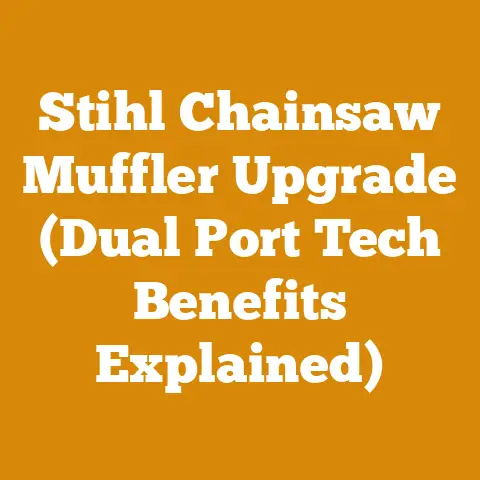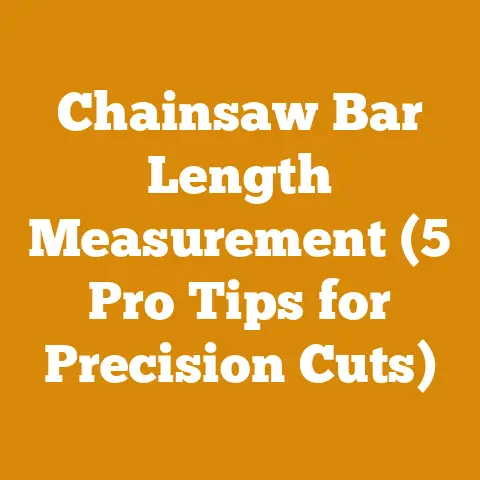Stihl Metal Blade Weed Eater Tips (5 Expert Blades for Tough Brush)
Have you ever wrestled with stubborn weeds and thick brush, feeling like your standard weed eater line just wasn’t up to the task?
I certainly have.
For years, I battled overgrown areas on my property, constantly replacing broken line and feeling frustrated with the lack of power.
That’s when I discovered the game-changing potential of metal blade attachments for my Stihl weed eater.
Now, I’m not talking about flimsy, easily-bent metal blades.
I’m talking about robust, expertly designed blades that can slice through thick vegetation like butter.
In this guide, I’ll share my experiences and knowledge on selecting and using the best metal blades for your Stihl weed eater.
I’ll delve into the world of brush cutting, explaining why these blades are essential for tackling tough jobs and how to choose the right one for your specific needs.
I’ll also provide a detailed, step-by-step guide on safely installing and using these blades, ensuring you get the most out of your investment while staying safe.
Why Metal Blades? A World Beyond Weed Eater Line
Before we dive into specific blades, let’s understand why metal blades are a superior choice for heavy-duty work.
Standard weed eater line, while effective for trimming grass and light weeds, struggles against thicker vegetation like brush, saplings, and dense weeds.
The line often breaks, wears down quickly, or simply bounces off the target.
Metal blades, on the other hand, offer several key advantages:
- Increased Cutting Power: Metal blades have sharpened edges designed to slice through tough vegetation with ease.
This significantly reduces the effort required and allows you to tackle jobs that would be impossible with line. - Durability: High-quality metal blades are made from hardened steel, making them incredibly durable and resistant to wear and tear.
They can withstand impacts with rocks, fences, and other obstacles that would quickly destroy standard weed eater line. - Efficiency: Because metal blades cut more effectively, you can complete jobs much faster.
This saves you time and reduces the strain on your weed eater’s engine. - Versatility: There’s a metal blade for almost any type of vegetation you might encounter.
From light brush to thick saplings, there’s a blade designed to handle the task.
Think of it this way: using weed eater line for heavy brush is like trying to cut down a tree with a butter knife.
It’s inefficient, frustrating, and ultimately ineffective.
Metal blades are the axe in this scenario, providing the power and precision you need to get the job done right.
Understanding the User Intent: Taming the Wild
The user’s intent behind searching for “Stihl Metal Blade Weed Eater Tips (5 Expert Blades for Tough Brush)” is clear: they’re facing challenging vegetation and seeking a solution that goes beyond standard weed eater line.
They want:
Expert Blade Recommendations: My Top 5 Choices
Through years of experience clearing brush and managing vegetation on my property, I’ve had the opportunity to test and evaluate numerous metal blades for Stihl weed eaters.
Based on my findings, here are my top 5 recommendations for tackling tough brush:
1. Stihl Brush Knife 230-4: The All-Around Workhorse
- Description: This is a four-tooth blade designed for cutting tough grass, weeds, and light brush.
It’s a versatile option suitable for a wide range of applications. - My Experience: The Stihl Brush Knife 230-4 is my go-to blade for general brush clearing.
I’ve used it to clear overgrown fields, trim along fence lines, and remove dense patches of weeds.
Its four-tooth design provides a good balance of cutting power and durability.
I’ve found it to be particularly effective against thick grasses and woody weeds. - Pros: Versatile, durable, good cutting power, relatively inexpensive.
- Cons: Not ideal for very thick brush or saplings.
- Specifications: Blade diameter: 9 inches (230 mm), Number of teeth: 4, Material: Hardened steel.
- Best For: General brush clearing, overgrown fields, trimming along fence lines.
2. Stihl WoodCut Blade: The Sapling Slayer
- Description: This blade resembles a small circular saw blade and is designed for cutting small trees and thick saplings.
- My Experience: When I needed to clear a patch of overgrown woodland, the Stihl WoodCut Blade was a lifesaver.
It effortlessly sliced through saplings up to 2 inches in diameter.
The key is to use a sweeping motion, allowing the blade to gradually cut through the wood.
I was impressed by its ability to quickly clear dense vegetation. - Pros: Excellent for cutting saplings and small trees, fast cutting speed, durable.
- Cons: Requires more skill to use safely, can be prone to kickback if not used properly.
- Specifications: Blade diameter: Typically 8 inches (200 mm), Number of teeth: Varies (usually around 80), Material: Hardened steel with carbide-tipped teeth.
- Best For: Cutting saplings, clearing small trees, removing thick brush.
3. Rotary Cutting Blade: The Shredder
- Description: This blade features multiple swinging blades that rotate at high speed, shredding vegetation on impact.
- My Experience: I used a rotary cutting blade to clear a large area of dense, tangled weeds and vines.
It was incredibly effective at shredding the vegetation into small pieces, making it easier to remove and dispose of.
The swinging blades are also less prone to kickback than fixed blades. - Pros: Excellent for shredding vegetation, less prone to kickback, good for clearing large areas.
- Cons: Can be messy, not as precise as other blades.
- Specifications: Blade diameter: Varies (typically 8-10 inches), Number of blades: Varies (usually 2-4), Material: Hardened steel.
- Best For: Clearing dense weeds and vines, shredding vegetation, large area clearing.
4. Stihl PolyCut Head: The Hybrid Solution
- Description: While not a metal blade in the traditional sense, the Stihl PolyCut Head uses plastic blades that are more durable and effective than standard weed eater line.
- My Experience: I initially dismissed the PolyCut Head as a gimmick, but I was pleasantly surprised by its performance.
The plastic blades are surprisingly tough and can handle thicker weeds and light brush.
They’re also much easier to replace than standard weed eater line.
I found it to be a good compromise between the convenience of line and the power of metal blades. - Pros: Easy to use, less prone to kickback, good for thicker weeds and light brush.
- Cons: Not as powerful as metal blades, plastic blades can wear down quickly.
- Specifications: Head diameter: Varies, Blade material: Durable plastic, Number of blades: Typically 2-3.
- Best For: Thicker weeds, light brush, general trimming.
5. Triangle Brushcutter Blade: The Aggressive Option
- Description: This blade features a triangular shape with sharpened edges on all three sides, providing aggressive cutting action.
- My Experience: When I needed to clear a particularly stubborn patch of thorny bushes, the Triangle Brushcutter Blade was the perfect tool.
Its aggressive cutting action quickly sliced through the thick stems.
However, it’s important to use this blade with caution, as it can be prone to kickback if not used properly. - Pros: Aggressive cutting action, good for thick brush and thorny bushes, durable.
- Cons: More prone to kickback, requires more skill to use safely.
- Specifications: Blade diameter: Varies (typically 8-10 inches), Shape: Triangular, Material: Hardened steel.
- Best For: Thick brush, thorny bushes, aggressive cutting.
Case Study: Clearing an Overgrown Fence Line
To illustrate the effectiveness of these blades, let’s consider a real-world example: clearing an overgrown fence line.
I had a section of fence that was completely obscured by weeds, brush, and vines.
Using standard weed eater line was a futile effort; the line kept breaking, and I made little progress.
Here’s how I tackled the project using metal blades:
- Assessment: I started by assessing the vegetation.
I identified a mix of thick grasses, woody weeds, and climbing vines. - Blade Selection: Based on the assessment, I chose the Stihl Brush Knife 230-4 for the grasses and weeds, and the Stihl WoodCut Blade for the thicker vines and small saplings that had grown along the fence.
- Safety Precautions: Before starting, I put on safety glasses, hearing protection, gloves, and long pants.
I also made sure the area was clear of people and pets. - Clearing the Grasses and Weeds: I used the Brush Knife to quickly clear the grasses and weeds along the fence line.
The blade easily sliced through the vegetation, leaving a clean path. - Cutting the Vines and Saplings: I then switched to the WoodCut Blade to tackle the thicker vines and saplings.
I used a sweeping motion, carefully cutting through the vegetation.
I was particularly careful to avoid kickback, keeping the blade moving and avoiding contact with solid objects. - Clean Up: After clearing the vegetation, I raked up the debris and disposed of it properly.
The result was a clean, clear fence line that was no longer obscured by vegetation.
The metal blades made the job much faster and easier than it would have been with standard weed eater line.
Choosing the Right Blade: Matching the Tool to the Task
Selecting the right metal blade is crucial for achieving optimal performance and ensuring safety.
Here’s a breakdown of the key factors to consider:
- Type of Vegetation: The most important factor is the type of vegetation you’ll be cutting.
For light grass and weeds, a Brush Knife or PolyCut Head may be sufficient.
For thicker brush and saplings, a WoodCut Blade or Triangle Brushcutter Blade is necessary. - Blade Diameter: The blade diameter determines the cutting width.
A larger diameter blade will cover more ground, but it may also be more difficult to control. - Number of Teeth: The number of teeth on a blade affects its cutting speed and aggressiveness.
More teeth generally provide a smoother, faster cut, but they may also be more prone to clogging in thick vegetation. - Blade Material: The blade material affects its durability and resistance to wear.
Hardened steel is the most common material, but some blades also feature carbide-tipped teeth for increased durability. - User Skill Level: Some blades, like the WoodCut Blade and Triangle Brushcutter Blade, require more skill to use safely.
If you’re a beginner, it’s best to start with a more forgiving blade like the Brush Knife or PolyCut Head. - Weed Eater Compatibility: Ensure the blade you choose is compatible with your Stihl weed eater model.
Check the owner’s manual for recommended blade sizes and types.
A Practical Matrix for Blade Selection
To help you visualize the blade selection process, here’s a practical matrix:
Safety First: A Non-Negotiable Priority
Using metal blades on a weed eater can be dangerous if proper safety precautions are not followed.
Always prioritize safety when operating any power equipment.
Here are some essential safety tips:
- Read the Owner’s Manual: Before using any metal blade, carefully read the owner’s manual for your Stihl weed eater.
Pay attention to the safety instructions and recommendations for blade usage. - Wear Protective Gear: Always wear safety glasses, hearing protection, gloves, and long pants when operating a weed eater with a metal blade.
A face shield or helmet is also recommended for added protection. - Inspect the Blade: Before each use, inspect the blade for any signs of damage, such as cracks, chips, or bends.
Replace the blade if it’s damaged. - Clear the Area: Before starting, clear the area of any obstacles, such as rocks, branches, or debris.
Also, make sure there are no people or pets nearby. - Use Proper Technique: Use a sweeping motion, keeping the blade moving and avoiding contact with solid objects.
Be aware of the potential for kickback, especially when using blades with fixed teeth. - Maintain a Safe Distance: Keep a safe distance from the blade at all times.
Never reach over or around the blade while it’s in operation. - Shut Off the Engine: Always shut off the engine before making any adjustments to the blade or clearing debris.
- Store Blades Safely: When not in use, store metal blades in a safe place, away from children and pets.
Kickback: Understanding and Preventing the Danger
Kickback is a sudden, forceful reaction that can occur when a metal blade strikes a solid object.
It can cause the weed eater to jerk violently, potentially throwing the operator off balance or causing the blade to strike them.
To prevent kickback:
- Use a sweeping motion: Keep the blade moving and avoid allowing it to get pinched or caught.
- Avoid contact with solid objects: Be especially careful when cutting near rocks, fences, or other obstacles.
- Use blades with anti-kickback features: Some blades are designed with features that reduce the risk of kickback.
- Maintain a firm grip: Keep a firm grip on the weed eater at all times.
- Be aware of your surroundings: Pay attention to the terrain and any potential hazards.
Personal Protective Equipment (PPE): Your First Line of Defense
Investing in high-quality PPE is essential for protecting yourself from injury.
Here’s a breakdown of the recommended PPE:
- Safety Glasses: Protect your eyes from flying debris.
- Hearing Protection: Protect your ears from the loud noise of the weed eater.
- Gloves: Protect your hands from cuts and abrasions.
- Long Pants: Protect your legs from flying debris and vegetation.
- Steel-Toed Boots: Protect your feet from injury.
- Face Shield or Helmet: Provide additional protection for your face and head.
Installation Guide: Getting Started with Metal Blades
Installing a metal blade on your Stihl weed eater is a relatively simple process, but it’s important to follow the instructions carefully to ensure proper installation and safe operation.
Tools You’ll Need:
- Wrench (usually included with the weed eater)
- Screwdriver (may be required depending on the model)
- Gloves (for hand protection)
- The metal blade you’ve chosen
Step-by-Step Instructions:
- Shut Off the Engine: Before starting, make sure the engine is completely shut off and the weed eater has cooled down.
Remove the spark plug wire for extra safety. - Remove the Existing Head: Depending on your weed eater model, you may need to remove the existing string trimmer head or blade.
Consult your owner’s manual for specific instructions.
Typically, this involves using a wrench to loosen a nut or bolt that secures the head to the shaft. - Install the Metal Blade: Place the metal blade onto the shaft, ensuring it’s properly aligned with the mounting holes.
- Install the Mounting Hardware: Install the washers, nuts, and bolts that secure the blade to the shaft.
Make sure the hardware is properly oriented according to the owner’s manual. - Tighten the Hardware: Use a wrench to tighten the nuts and bolts securely.
Do not overtighten, as this could damage the blade or the weed eater. - Check for Proper Rotation: Before starting the engine, manually rotate the blade to ensure it spins freely and doesn’t rub against any parts of the weed eater.
- Reconnect the Spark Plug Wire: Reconnect the spark plug wire to the spark plug.
- Test the Blade: Start the engine and carefully test the blade in a safe area.
Make sure it’s cutting properly and there are no unusual vibrations or noises.
Important Considerations:
- Owner’s Manual: Always refer to your Stihl weed eater’s owner’s manual for specific installation instructions and safety precautions.
- Blade Orientation: Ensure the blade is installed with the correct cutting edge facing outwards.
- Hardware Compatibility: Use only the hardware that is specifically designed for your weed eater and the metal blade you’re installing.
- Torque Specifications: If your owner’s manual provides torque specifications for the mounting hardware, use a torque wrench to ensure proper tightening.
Maintenance and Care: Extending the Life of Your Blades
Proper maintenance and care will significantly extend the life of your metal blades and ensure optimal performance.
Here are some key maintenance tips:
- Sharpening: Regularly sharpen your metal blades to maintain their cutting edge.
A dull blade will require more effort to use and can be more prone to kickback.
Use a file or grinder to sharpen the blade, following the manufacturer’s instructions. - Cleaning: After each use, clean the blade with a brush or cloth to remove any debris, such as grass, weeds, or sap.
- Lubrication: Apply a light coat of oil to the blade to prevent rust and corrosion.
- Storage: When not in use, store the blade in a dry place, away from moisture and extreme temperatures.
- Inspection: Regularly inspect the blade for any signs of damage, such as cracks, chips, or bends.
Replace the blade if it’s damaged.
Sharpening Your Blades: A Step-by-Step Guide
Sharpening metal blades is crucial for maintaining their cutting efficiency and extending their lifespan.
Here’s a step-by-step guide:
- Secure the Blade: Clamp the blade in a vise to hold it securely.
- Choose the Right Tool: Use a metal file or a grinding wheel designed for sharpening metal blades.
- Follow the Original Angle: Maintain the original cutting angle of the blade while sharpening.
This is crucial for preserving the blade’s performance. - Sharpen Each Tooth: Carefully sharpen each tooth of the blade, removing any burrs or imperfections.
- Balance the Blade: After sharpening, check the blade for balance.
An unbalanced blade can cause excessive vibration and wear on the weed eater. - Deburr the Blade: Use a fine file or honing stone to remove any sharp edges or burrs from the blade.
When to Replace a Blade: Recognizing the Signs
Knowing when to replace a metal blade is crucial for safety and performance.
Here are some signs that indicate it’s time for a replacement:
- Cracks or Chips: Any cracks or chips in the blade are a sign that it’s weakened and could break during use.
- Bends or Warping: A bent or warped blade will not cut properly and can be dangerous to use.
- Excessive Wear: If the blade is significantly worn down, it will no longer be effective at cutting vegetation.
- Difficulty Sharpening: If you’re having difficulty sharpening the blade, it may be time to replace it.
Strategic Advantages: Beyond the Basics
Using metal blades on your Stihl weed eater offers several strategic advantages beyond simply cutting tougher vegetation:
- Increased Efficiency: Metal blades allow you to complete jobs much faster, saving you time and effort.
- Reduced Labor Costs: If you’re a landscaping professional, using metal blades can reduce your labor costs by allowing you to complete jobs more quickly.
- Improved Results: Metal blades provide a cleaner, more precise cut than standard weed eater line, resulting in a more professional-looking finish.
- Enhanced Versatility: With the right metal blade, you can tackle a wider range of vegetation types, making your weed eater a more versatile tool.
- Extended Equipment Life: By using the appropriate blade for the job, you can reduce the strain on your weed eater’s engine, potentially extending its lifespan.
Cost Analysis: Metal Blades vs. Weed Eater Line
While metal blades may have a higher initial cost than standard weed eater line, they can often be more cost-effective in the long run.
Here’s a simple cost analysis:
- Weed Eater Line:
- Lower initial cost
- Frequent replacement required
- Less efficient for tough vegetation
- Higher labor costs (due to frequent replacement and slower cutting speed)
- Metal Blades:
- Higher initial cost
- More durable and longer-lasting
- More efficient for tough vegetation
- Lower labor costs (due to faster cutting speed and less frequent replacement)
In many cases, the increased efficiency and durability of metal blades can offset their higher initial cost, making them a more cost-effective choice in the long run.
Conclusion: Embrace the Power of Metal
Upgrading your Stihl weed eater with metal blades can transform it from a simple trimming tool into a powerful brush-clearing machine.
By selecting the right blade for the job, following proper safety precautions, and maintaining your equipment properly, you can tackle even the toughest vegetation with ease.
My journey from struggling with ineffective weed eater line to confidently clearing brush with metal blades has been transformative.
I hope this guide has provided you with the knowledge and confidence you need to embark on your own brush-clearing adventures.
Remember to prioritize safety, choose the right blade for the task, and maintain your equipment properly.
With these principles in mind, you’ll be well on your way to conquering even the most challenging vegetation.
Next Steps:
- Assess your needs: Determine the types of vegetation you’ll be cutting and choose the appropriate metal blade.
- Purchase the necessary equipment: Order the metal blade, safety gear, and any tools you may need for installation and maintenance.
- Install the blade: Follow the installation instructions carefully.
- Practice in a safe area: Before tackling a large project, practice using the blade in a safe area to get a feel for its handling and cutting characteristics.
- Start clearing brush! Enjoy the power and efficiency of your upgraded Stihl weed eater.






